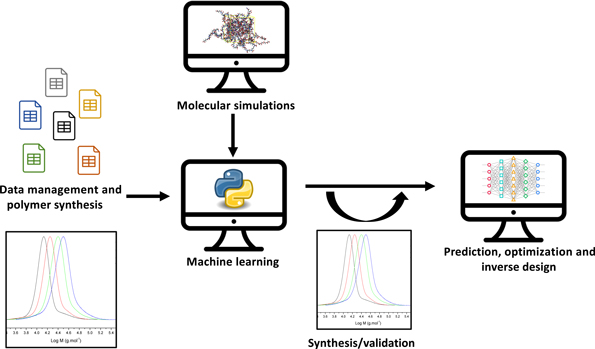Crossref Citations
This article has been cited by the following publications. This list is generated based on data provided by
Crossref.
Rizkin, Benjamin A.
and
Hartman, Ryan L.
2020.
Activation of homogenous polyolefin catalysis with a machine-assisted reactor laboratory-in-a-box (μAIR-LAB).
Reaction Chemistry & Engineering,
Vol. 5,
Issue. 8,
p.
1450.
Schuett, Timo
Kimmig, Julian
Zechel, Stefan
and
Schubert, Ulrich S.
2020.
Automated Polymer Purification Using Dialysis.
Polymers,
Vol. 12,
Issue. 9,
p.
2095.
Knox, Stephen T.
and
Warren, Nicholas J.
2020.
Enabling technologies in polymer synthesis: accessing a new design space for advanced polymer materials.
Reaction Chemistry & Engineering,
Vol. 5,
Issue. 3,
p.
405.
Hedden, Ronald C
2020.
High-throughput screening of polymeric membranes for liquid mixture separation.
Current Opinion in Chemical Engineering,
Vol. 28,
Issue. ,
p.
83.
Park, Nathaniel H.
Zubarev, Dmitry Yu.
Hedrick, James L.
Kiyek, Vivien
Corbet, Christiaan
and
Lottier, Simon
2020.
A Recommender System for Inverse Design of Polycarbonates and Polyesters.
Macromolecules,
Vol. 53,
Issue. 24,
p.
10847.
Chen, Guang
Shen, Zhiqiang
Iyer, Akshay
Ghumman, Umar Farooq
Tang, Shan
Bi, Jinbo
Chen, Wei
and
Li, Ying
2020.
Machine-Learning-Assisted De Novo Design of Organic Molecules and Polymers: Opportunities and Challenges.
Polymers,
Vol. 12,
Issue. 1,
p.
163.
Kimmig, Julian
Zechel, Stefan
and
Schubert, Ulrich S.
2021.
Digital Transformation in Materials Science: A Paradigm Change in Material's Development.
Advanced Materials,
Vol. 33,
Issue. 8,
Tammaro, Daniele
D'Avino, Gaetano
Costanzo, Salvatore
Di Maio, Ernesto
Grizzuti, Nino
and
Maffettone, Pier Luca
2021.
A microcapillary rheometer for microliter sized polymer characterization.
Polymer Testing,
Vol. 102,
Issue. ,
p.
107332.
Luengo, Gustavo S.
Fameau, Anne-Laure
Léonforte, Fabien
and
Greaves, Andrew J.
2021.
Surface science of cosmetic substrates, cleansing actives and formulations.
Advances in Colloid and Interface Science,
Vol. 290,
Issue. ,
p.
102383.
Hagita, Katsumi
Aoyagi, Takeshi
Abe, Yuto
Genda, Shinya
and
Honda, Takashi
2021.
Deep learning-based estimation of Flory–Huggins parameter of A–B block copolymers from cross-sectional images of phase-separated structures.
Scientific Reports,
Vol. 11,
Issue. 1,
Chowdhury, Mohammad Asaduzzaman
Hossain, Nayem
Ahmed Shuvho, Md Bengir
Fotouhi, Mohammad
Islam, Md Sakibul
Ali, Md Ramjan
and
Kashem, Mohammod Abul
2021.
Recent machine learning guided material research - A review.
Computational Condensed Matter,
Vol. 29,
Issue. ,
p.
e00597.
Tan, Yu Jun
Susanto, Glenys Jocelin
Anwar Ali, Hashina Parveen
and
Tee, Benjamin C. K.
2021.
Progress and Roadmap for Intelligent Self‐Healing Materials in Autonomous Robotics.
Advanced Materials,
Vol. 33,
Issue. 19,
Selvaratnam, Balaranjan
and
Koodali, Ranjit T.
2021.
Machine learning in experimental materials chemistry.
Catalysis Today,
Vol. 371,
Issue. ,
p.
77.
Ethier, Jeffrey G.
Casukhela, Rohan K.
Latimer, Joshua J.
Jacobsen, Matthew D.
Rasin, Boris
Gupta, Maneesh K.
Baldwin, Luke A.
and
Vaia, Richard A.
2022.
Predicting Phase Behavior of Linear Polymers in Solution Using Machine Learning.
Macromolecules,
Vol. 55,
Issue. 7,
p.
2691.
Hernández, Valentina
Ibarra, Davor
Triana, Johan F.
Martínez-Soto, Bastian
Faúndez, Matías
Vasco, Diego A.
Gordillo, Leonardo
Herrera, Felipe
García-Herrera, Claudio
and
Garmulewicz, Alysia
2022.
Agar Biopolymer Films for Biodegradable Packaging: A Reference Dataset for Exploring the Limits of Mechanical Performance.
Materials,
Vol. 15,
Issue. 11,
p.
3954.
Bejagam, Karteek K.
Lalonde, Jessica
Iverson, Carl N.
Marrone, Babetta L.
and
Pilania, Ghanshyam
2022.
Machine Learning for Melting Temperature Predictions and Design in Polyhydroxyalkanoate-Based Biopolymers.
The Journal of Physical Chemistry B,
Vol. 126,
Issue. 4,
p.
934.
Yue, Liang
Kuang, Xiao
Sun, Xiaohao
and
Qi, H. Jerry
2022.
Recent Advances in Smart Self-Healing Polymers and Composites.
p.
483.
Champa-Bujaico, Elizabeth
García-Díaz, Pilar
and
Díez-Pascual, Ana M.
2022.
Machine Learning for Property Prediction and Optimization of Polymeric Nanocomposites: A State-of-the-Art.
International Journal of Molecular Sciences,
Vol. 23,
Issue. 18,
p.
10712.
Feng, Yu
Tang, Wenxin
Zhang, Yue
Zhang, Tiandong
Shang, Yanan
Chi, Qingguo
Chen, Qingguo
and
Lei, Qingquan
2022.
Machine learning and microstructure design of polymer nanocomposites for energy storage application.
High Voltage,
Vol. 7,
Issue. 2,
p.
242.
Zou, Weizhong
Martell Monterroza, Alexis
Yao, Yunxin
Millik, S. Cem
Cencer, Morgan M.
Rebello, Nathan J.
Beech, Haley K.
Morris, Melody A.
Lin, Tzyy-Shyang
Castano, Cleotilde S.
Kalow, Julia A.
Craig, Stephen L.
Nelson, Alshakim
Moore, Jeffrey S.
and
Olsen, Bradley D.
2022.
Extending BigSMILES to non-covalent bonds in supramolecular polymer assemblies.
Chemical Science,
Vol. 13,
Issue. 41,
p.
12045.
